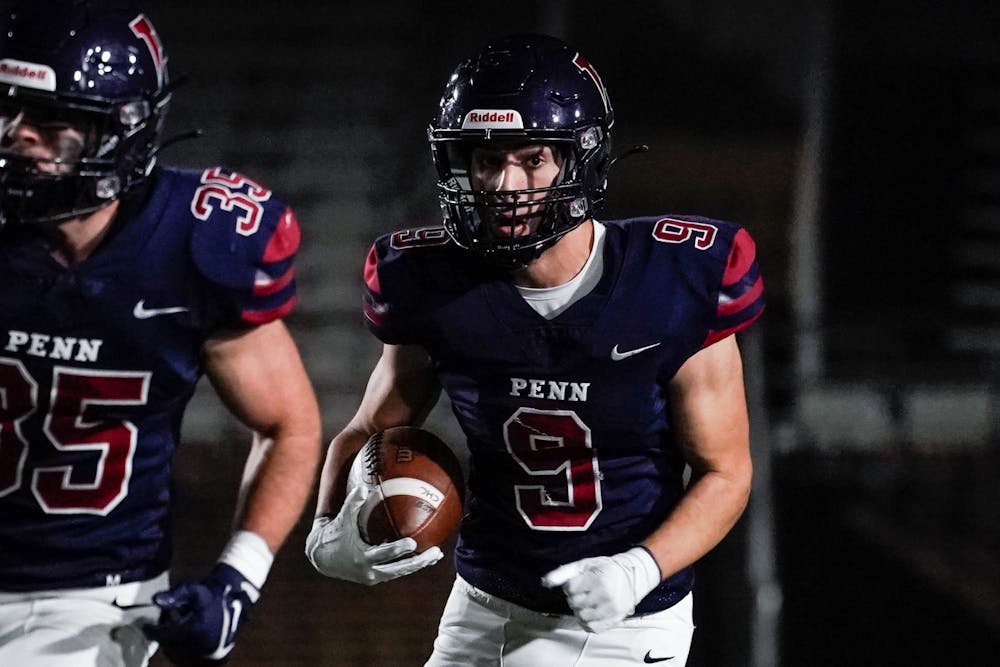
You probably wouldn’t expect a guy with seven screws and a six-inch plate in his left ankle to be playing football. And even if he did, you probably wouldn’t expect him to be playing cornerback, a position that arguably requires some of the quickest and most agile feet on the field.
But if he somehow managed to accomplish both of those things, and he found himself playing an already difficult position with an injury that would seem like a cornerback’s kryptonite, he would probably need to have already played football for a number of years.
Well, that’s not the case for Jordan Ortiz, a sophomore on the Penn sprint football team from Westfield, N.J., who suffered a brutal injury in the summer before his senior season of high school. Up until his junior year, he’d actually never touched the football field.
“I thought I’d be a backup on [junior varsity], and then I was pulled up,” Ortiz said. “After preseason camp, I was a varsity starter. So that was pretty cool after not playing football at all.”
Ortiz’s preseason the following year, however, did not go quite as well, as he jumped to defend a pass and came down on his left ankle in the wrong direction, forcing him to have emergency surgery that included seven screws and a six-inch plate.
Ortiz’s recovery was arduous. With titanium now in his ankle, he had to relearn how to walk and was doing physical therapy for around seven months. From there, Ortiz had five to six months to learn how to play football again.
At the time, Ortiz had coincidentally just started talking with Penn’s sprint football coaching staff.
“I knew I had wanted to go to Penn since I was a kid ... My mom [was] just randomly scrolling through the Penn athletics website [and] goes, ‘Oh, there’s this thing called sprint football.’”
Ortiz then decided to send in his “very limited tape” and academic records. From there, his discussions with the team began.
“One of the first times I ever talked to coach [Jerry McConnell] was when I was going in for surgery … It was a good phone call … I just didn’t think I’d be able to play again.”
But somehow, he managed, and Ortiz became a starter at Penn in his first year, finishing the season with the second-most pass breakups in the Collegiate Sprint Football League. Now a sophomore, he’s continued the same strong performance. In the Quakers’ game last week against Chestnut Hill, Ortiz amassed two interceptions, earning him CSFL Defensive Player of the Week.
Ortiz attributes his recent success to his diligence with film and its impact on the field.
“The mental aspect of the game is the most important … [W]e’re all the same size, [with] pretty similar ability, but I think what separates the good from the great is how much time you put in outside of practice,” he said.
He’d learned that lesson while he was sidelined during his senior year, when the most he could do was watch YouTube videos on his phone and look at old film.
With obvious limitations on Ortiz's physical mobility, dedicating his time to the mental aspect of the game was a new focus. He continues to utilize film extensively even now that he’s healthy. But even with such an impressive comeback story, it’s hard not to wonder why he’s still playing football. Health risks aside, you’d assume the football field might be a bit traumatizing.
Even after a brutal football injury had derailed his senior year of high school and caused him to be, as he puts it, “at [his] lowest,” what motivates him to continue stepping on that field?
“To prove to myself that I can keep going.”
The Daily Pennsylvanian is an independent, student-run newspaper. Please consider making a donation to support the coverage that shapes the University. Your generosity ensures a future of strong journalism at Penn.
Donate







